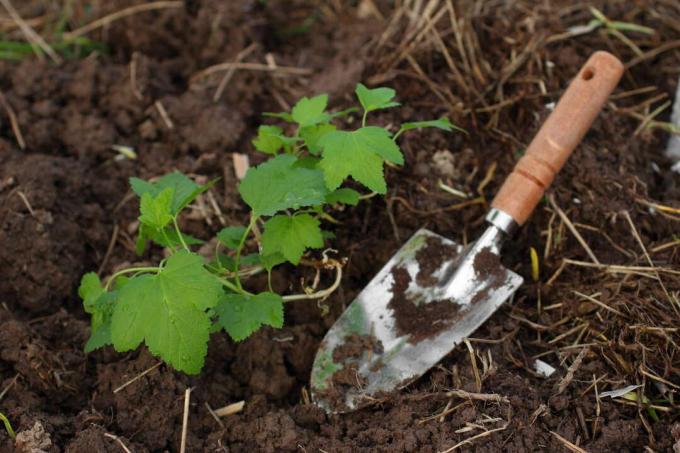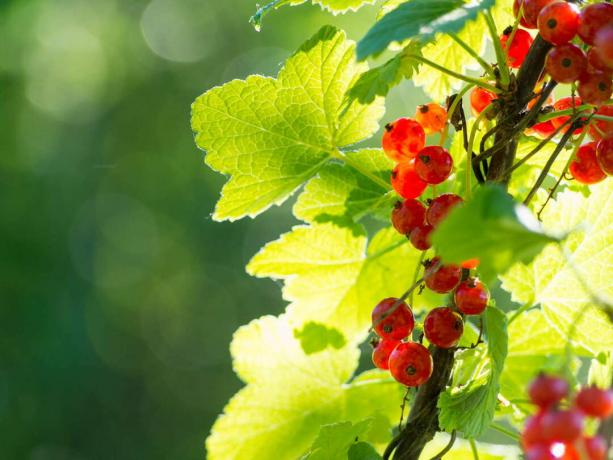When planting currants, there are a few things to consider: From the location and the right time to the planting instructions, we share our tips.

currants (Ribes) can be planted as a garden hedge, as a border for vegetable beds or the compost heap or simply in a berry bed. They are adapted to our climate and therefore thrive quite well almost everywhere. Nevertheless, they naturally have some preferences in terms of their location, the prevailing soil conditions and their care. With the following information, you are well equipped to soon be able to harvest plenty of delicious currants in your own garden.
contents
- Planting currants: Choosing a location
- Planting currants: the right time
-
Planting currants: Instructions in 4 steps
- 1. Prepare site for currants
- 2. Dig a planting hole
- 3. Perform plant pruning
- 4. plant currants
Planting currants: Choosing a location
Although currants also thrive in partial shade, we advise you to plant them in a sunny spot. Not only will the harvest there be larger, but the fruits will also be sweeter the more sun your plant gets. If you only have a half-shady place available, the white currants (
Ribes sativa) recommended: They are a bit sweeter anyway and sometimes even grow better in semi-shade. Currant plants feel most comfortable in medium-heavy, nutrient-rich soil that can retain moisture well. A slightly acidic pH of 5.5 to 6 is ideal. Currants are also flat-rooted. This means that they do not need deep soil and can also be planted in low beds or large containers around 40 cm high. Due to the fact that their roots do not reach deep, currants have to be watered more frequently when it is dry. This is especially true if they are in a sunny spot. A layer of mulch often helps to keep the soil moist.The right location for currants in brief:
- Sunny, semi-shady is fine too
- medium-heavy, nutrient-rich, moist, slightly acidic soil
- The soil does not have to be deep, so plant troughs or low beds are also suitable

Planting currants: the right time
Currants, like most berry bushes and fruit trees, are best planted in the fall. Then the currants can benefit from the winter moisture and sprout quickly and well next year. Container plants, which are mostly sold today, can theoretically be planted all year round. Then you should just make sure that the plant does not dry out in the first few weeks. Nevertheless, if planting in autumn is not possible, we advise you to plant currants in early spring. Because at this time of year the soil is still nice and damp.
Planting currants: Instructions in 4 steps
Once you have found a suitable location, you can start planting. To ensure that this process is crowned with success, we have summarized all the important steps below.
1. Prepare site for currants
Before planting, you should prepare the soil for the currants, also carefully remove weeds around the future planting hole and its surroundings. Because once persistent weeds such as goutweed, couch grass, stinging nettles or bindweed grow in the rootstock of the currants, they are difficult to remove.
2. Dig a planting hole
Then a generous planting hole is dug, which is about twice as big and deep as the root ball of the currant plant. You should loosen the soil underneath and next to it a little with a digging fork so that the roots can penetrate better. Then put some compost mixed with topsoil back into the planting hole. In our article “What is topsoil?” we will explain to you in more detail what it is all about.

3. Perform plant pruning
The most beautiful and strongest five to six shoots, which ideally grow in different directions, are shortened to about a third of the existing shoot length. Make sure that there are still about four buds on all shoots. You should always clip above an outward-facing bud. If there are more than five to six shoots, the rest are cut off a few centimeters above the ground. This pruning, which initially appears quite radical, stimulates budding and thus the development of a magnificent shrub.
4. plant currants
The root ball of the currant is immersed in water for a while until it is nice and damp. The plant is then placed in the planting hole, with red varieties (Ribes rubrum) can be planted a few centimeters lower than they were previously in the pot (container) or in the nursery. Black Varieties (Ribes nigrum) you should plant a whole hand's breadth deeper than before. As a result, many new shoots emerge from the rootstock, which black currants are very important. These only bear on the one-year shoots.

The planting hole is filled with nutrient-rich organic soil so that the shallow-rooted plants can find enough nutrients in the upper soil layers. Our peat-free, for example, is well suited Plantura organic universal soil. If there are several currant bushes next to each other, there is a distance of 1.3 to 1.8 m between red and white currants - depending on growth - or of 2 m between black currants proven. With this spacing, the shrubs are well ventilated and less susceptible to fungal diseases. If you plant several rows, there should be about 2 to 2.5 m space between the rows in order to be able to cut, harvest and water the shrubs well.
The soil is lightly trampled and the shrub well watered. Finally, the soil surface is covered with a layer of mulch made from lawn clippings, straw, manure or bark mulch. This helps keep the soil moist and provides additional nutrients.
Planting currants: our summary
- Clear the ground of weeds
- Dig a planting hole and loosen the soil next to and below it with a digging fork
- The strongest 5 to 6 shoots are cut back to about a third of their length, but at most so far that about 4 buds remain; Cut off the remaining shoots close to the ground
- Soak the root ball in water for about half a minute until well soaked with water
- Plant red and white currants a few centimeters lower than originally and black currants a hand's breadth lower than before in the pot
- Fill with organic soil, press down and water generously
- Cover the soil surface with mulch (bark mulch on calcareous soils, otherwise grass clippings, straw, manure, etc.).
Now you just have to make sure that the plants do not dry out as long as they are not yet well rooted. In the years to come it will be particularly important Cut currants regularly. In addition, one should pay attention to the to fertilize currants and water when dry. That's all it takes for your currant plant to reward you with sweet and sour fruits year after year.


